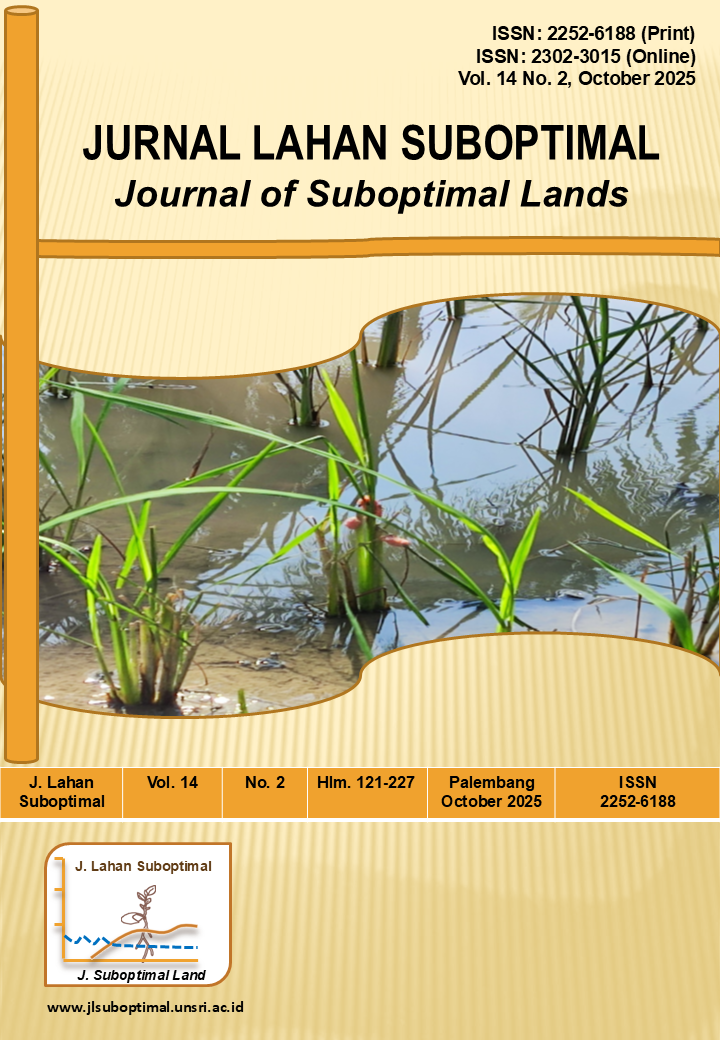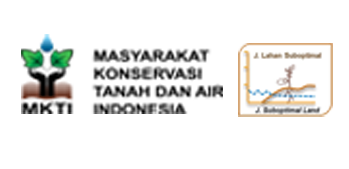Diversity and role of insects on vegetation around sugar palm (Arenga pinnata) plants in Tanjung Miring Village, Muara Enim Regency
DOI:
https://doi.org/10.36706/jlso.14.2.2025.745Keywords:
diversity, insects, species, sugar palm, trapAbstract
Arenga pinnata (sugar palm) was a crop of high ecological, economic, and social in South Sumatra, particularly in Muara Enim Regency. Despite its importance, limited scientific information regarding the diversity and ecological functions of insect communities associated with this species. This study aimed to identify and classify insect taxa specifically decomposers, phytophagous, pollinators, and natural enemies found in and around sugar palm stands in Tanjung Miring Village. Field observations were conducted using purposive sampling, and insect specimens were collected through four established methods: yellow sticky traps, pitfall traps, sweep nets, and manual hand collection. A total of 850 insect individuals were recorded, with the greatest abundance observed on trees possessing trunk diameters between 31‒40 cm. Hymenoptera was the most frequently encountered order, with Monomorium minimum identified as the most dominant species. Among the collection methods, yellow sticky traps yielded the highest number of individuals. Biodiversity analysis revealed a Shannon-Wiener index (H′) of 2.47, indicating moderate diversity. The evenness index (E) was 0.73, suggesting relatively low species distribution uniformity, while the dominance index (D) was 0.13, implying the absence of a single dominant species within the community. Statistical analysis using NCSS software demonstrated a significant effect of trap type on insect abundance, but no significant differences were found based on insect order, tree diameter, or observation period. These findings underscore the ecological importance of insect diversity in sugar palm ecosystems, as various functional groups such as pollinators, herbivores, and decomposers play vital roles in supporting the growth, productivity, and sustainability.
References
Akbar, D. A., Yuniastuti, E., & Supriyono, S. (2025). The influence of altitude toward vegetative and generative growth of sugar palm (Arenga pinnata). Journal Agro Bali, 8(1), 56–63.
Aminatun, T., Suwasono, R. A., & Putri, R. A. (2021). Flora and fauna diversity in selangkau forest: A basis for developing management plan of cement industrial complex in east Kalimantan, Indonesia. Biodiversitas, 22(10), 4555–4565. https://doi.org/10.13057/biodiv/d221049
Amrulloh, M. F. F., Kamaludin, K., Atini, B., Priyambodo, H. Y., & Moi, M. Y. (2022). Diversity, evenness, and species richness of aerial insects in dry land of Kefamenanu, North Central Timor, East Nusa Tenggara. Advances in Tropical Biodiversity and Environmental Sciences, 6(3), 98‒106. https://doi.org/10.24843/atbes.2022.v06.i03.p06
Asyraf, M. R. M., Syamsir, A., Supian, A. B. M., Usman, F., Ilyas, R. A., Nurazzi, N. M., Norrrahim, M. N. F., Razman, M. R., Zakaria, S. Z. S., Sharma, S., Itam, Z., & Rashid, M. Z. A. (2022). Sugar palm fibre-reinforced polymer composites: influence of chemical treatments on its mechanical properties. Materials, 15(11), 1‒22. https://doi.org/10.3390/ma15113852
Budiaman, Nuraeni, S., & Ramli. (2023). Diversity of insects on bitti stands (Vitex cofassus). IOP Conference Series: Earth and Environmental Science, 1192(1), 1‒10. https://doi.org/10.1088/1755-1315/1192/1/012030
Buxton, J. T., Robert, K. A., Marshall, A. T., Dutka, T. L., & Gibb, H. (2021). A cross-species test of the function of cuticular traits in ants. Myrmecological News, 31, 31–46. https://doi.org/10.25849/myrmecol.news
Darsono, Riwidiharso, E., Santoso, S., Sudiana, E., Yani, E., Nasution, E. K., Aprilliana, H., & Chasanah, T. (2020). Insect diversity in various distances to forest edge in small nature reserve: A case study of bantarbolang nature reserve, Central Java, Indonesia. Biodiversitas, 21(10), 4821–4828. https://doi.org/10.13057/biodiv/d211048
Dasrat, C. M., & Maharaj, G. (2021). Biological control of mosquitoes with odonates: a case study in Guyana. Nusantara Bioscience, 13(2), 163–170. https://doi.org/10.13057/nusbiosci/n130205
Daud, I. D., Melina, F., Hadiwijaya, A. S., & Ardianto. (2021). Arthropod diversity and corn stem borer Ostrinia furnacalis Guenee population in corn endophytes. IOP Conference Series: Earth and Environmental Science, 807(2), 1‒8 https://doi.org/10.1088/1755-1315/807/2/022099
Diarra, U., Osborne-Naikatini, T., & Subramani, R. (2024). Actinomycetes associated with hymenopteran insects: a promising source of bioactive natural products. Frontiers in Microbiology, 15(February), 1‒20. https://doi.org/10.3389/fmicb.2024.1303010
Diratika, M., Yaherwandi, & Efendi, S. (2020). Abundance of predatory ladybugs (Hemiptera: Reduviidae) and fire caterpillars in oil palm plantationst. Jurnal Penelitian Pertanian Terapan, 20(1), 1–10.
Egwutvongsa, S. (2021). Influence factors on industrial handmade products designed from sugar palm fibers. Strategic Design Research Journal, 14(2), 456–470. https://doi.org/10.4013/sdrj.2021.142.06
Haryono, Ainulia, A. D. R., & Putra, M. R. T. J. (2021). Identification of soil insects in the sokemboi ronting plantation, Lamba Leda District, East Manggarai Regency. Jurnal Sains dan Pendidikan Biologi, 4(2), 47–52. https://doi.org/10.51336/cb.v4i2.272
Herlin, W., Fitriyani, D., Akbario, R., Aziz, M., Nurfadila, Y., Muhammad, G., & Rizkawati, V. (2024). Pollinator insects on sugar palm (Arenga pinnata Merr.) in South Sumatera, Indonesia. IOP Conference Series: Earth and Environmental Science, 1346(1), 1‒13. https://doi.org/10.1088/1755-1315/1346/1/012025
Imraan, M., Ilyas, R. A., Norfarhana, A. S., Bangar, S. P., Knight, V. F., & Norrrahim, M. N. F. (2023). Sugar palm (Arenga pinnata) fibers: new emerging natural fibre and its relevant properties, treatments and potential applications. Journal of Materials Research and Technology, 24, 4551–4572. https://doi.org/10.1016/j.jmrt.2023.04.056
Indriati, G., Susilawati, Puspitasari, M., Soesanthy, F., & Tresniawati, C. (2022). Insect diversity on toxic candlenut (Reutealis trisperma) plantation in Bajawa, East Nusa Tenggara. IOP Conference Series: Earth and Environmental Science, 974(1), 1‒8. https://doi.org/10.1088/1755-1315/974/1/012131
Jankielsohn, A. (2023). Sustaining insect biodiversity in agricultural systems to ensure future food security. Frontiers in Conservation Science, 4(June), 1–8. https://doi.org/10.3389/fcosc.2023.1195512
Katumo, D. M., Liang, H., Ochola, A. C., Lv, M., Wang, Q. F., & Yang, C. F. (2022). Pollinator diversity benefits natural and agricultural ecosystems, environmental health, and human welfare. Plant Diversity, 44(5), 429–435. https://doi.org/10.1016/j.pld.2022.01.005
Kenny, Y., & Jacob, Y. K. (2021). Cultivating aren trees with environmental insight : preparing rural communities that have quality especially for aren tree farmers in Motoling Village. International Research Journal of Management, 8(6), 613–618.
Khairuddin, W. N., Hamid, S. N. A. A., Mansor, M. S., Bharudin, I., Othman, Z., & Johari jalinas. (2022). A Review of entomopathogenic nematodes as a biological control agent for red palm weevil, Rhynchophorus ferrugineus (Coleoptera: Curculionidae). Insects, 13(3), 1‒15. http://dx.doi.org/10.3390/insects13030245
Krissetya, Y. A., Sari, D. P., Apriyanto, D., & Nufus, M. (2021). Potential distribution of sugar palm in Jepara Regency for soil conservation and climate change mitigation. IOP Conference Series: Earth and Environmental Science, 824(1), 1‒8. https://doi.org/10.1088/1755-1315/824/1/012011
Kumar, H. (2024). Physiological adaptive mechanisms of insects in different habitats. Animal Diversity : Taxonomical and Physiological Aspects, September. 219‒240.
Latumahina, F. S., Mardiatmoko, G., & Sahusilawane, J. (2020). Richness, diversity and evenness of birds in small island.
Journal of Physics: Conference Series, 1463, 1‒14. https://doi.org/10.1088/1742-6596/1463/1/012023
Liputo, S. M., Lamondo, D., & Solang, M. (2022). Effect of palm sap (Arenga pinnata) on blood glucose levels of mice (Mus musculus) alloxan-induced diabetic. Asian Journal of Natural Product Biochemistry, 20(1), 11–15. https://doi.org/10.13057/biofar/f200103
Mawan, A., Hartke, T. R., Deharveng, L., Zhang, F., Buchori, D., Scheu, S., & Drescher, J. (2022). Response of arboreal Collembola communities to the conversion of lowland rainforest into rubber and oil palm plantations. BMC Ecology and Evolution, 22(1), 1–13. https://doi.org/10.1186/s12862-022-02095-6
Muda, M., Muda, N. A., & Awal, A. (2024). Sugar palm (Arenga pinnata Wurmb Merr.): its potential, limitation, and impact on socio-economic development of rural communities in Malaysia. Journal of Natural Fibre Polymer Composites (JNFPC), 3(1), 2821–3289.
Mujetahid, A., Muin, A. V. F., & Wulan, S. (2023). Potential of aren (Arenga pinnata) in KHDTK Hasanuddin University Educational Forest, Rompegading Village, Cenrana District, Maros Regency. IOP Conference Series: Earth and Environmental Science, 1277(1), 1‒8. https://doi.org/10.1088/1755-1315/1277/1/012013
Patty, T., Jeremy, Arianto, W., & Suhartoyo, H. (2022). Study of the corpse flower (Amorphophallus titanum) population at KHDTK UNIB, North Bengkulu Regency, Bengkulu Province. Journal of Global Forest and Environmental Science, 2(3), 78–89.
Rohman, F., Diwanata, B., Priambodo, B., & Putra, W. E. (2021). Community structure studies of birds as component evaluation of habitat and ecosystem condition at water sources in Malang Raya. IOP Conference Series: Earth and Environmental Science, 743(1), 1‒8. https://doi.org/10.1088/1755-315/743/1/012040
Santhoshkumar, S., Gomathi, V., Meenakshisundaram, P., & Kavitha Mary, J. (2024). Comparative insights of soil properties of termite hill in relation to the microbial community using culture-independent approach. Total Environment Advances, 9(June 2023), 1‒12. https://doi.org/10.1016/j.teadva.2023.200094
Simamora, L., Zebua, D. D. N., Handoko, Y. A., & Widyawati, N. (2021). The Continuity of Palm Sugar Production: A Literature Review. Jurnal Ilmiah Membangun Desa Dan Pertanian, 6(2), 37‒43. https://doi.org/10.37149/jimdp.v6i2.17210
Siregar AZ, Tulus, Yunilas, & Nisa, S. C. A. (2022). Inventory insects of sorghum plantation in Northern Sumatera, Indonesia. IOP Conference Series: Earth and Environmental Science, 977(1), 0–8. https://doi.org/10.1088/1755-1315/977/1/012105
Sunarsih, F., Pujiastuti, Y., Mulawarman, M., Nurhayati, N., & Panandi, A. (2020). Diversity of soil inhabiting arthropods in intercropping of chili and chinese mustard green applied with bacillus thuringiensis based bio-insecticides and synthetic insecticides treatment. Sriwijaya Journal of Environment, 5(2), 76–81. https://doi.org/10.22135/sje.2020.5.2.76-81
Surbakti, J., Sitepu, S. F., & Oemry, S. (2018). Insect diversity in cocoa (Theobroma cacao L.) plantations using IPM and non-IPM techniques in Biru-Biru District, Deli Serdang Regency. Jurnal Agroekoteknologi FP USU, 6(2), 320–329.
Syari, Y. rahma, Kanedi, M., Chrisnawati, L., & Mahfut. (2023). Diversity of pollinating insects in the Lumbok Seminung Biodiversity Park, West Lampung. Jurnal Unib, 280(1), 58–64.
Wardani, D. K., Junaedi, A., Yahya, S., & Sunarti, T. C. (2020). Morphological characteristics and productivity of sugar palm saps at several levels of tapping age. IOP Conference Series: Earth and Environmental Science, 418(1), 1‒10. https://doi.org/10.1088/1755-1315/418/1/012040
Zulkifli, M., Izzati, N., Arina, A., & Jasmin, N. (2024). A comparative study of blue and yellow sticky traps for insect monitoring on tomato organic farm in Mardi Cameron Highlands. AgroTech: Food Science, Technology and Environment, 1, 22–28.
Downloads
Published
How to Cite
Issue
Section
License
Copyright (c) 2025 Dhiva Kinanti Diadara, Weri Herlin

This work is licensed under a Creative Commons Attribution-NonCommercial-ShareAlike 4.0 International License.













